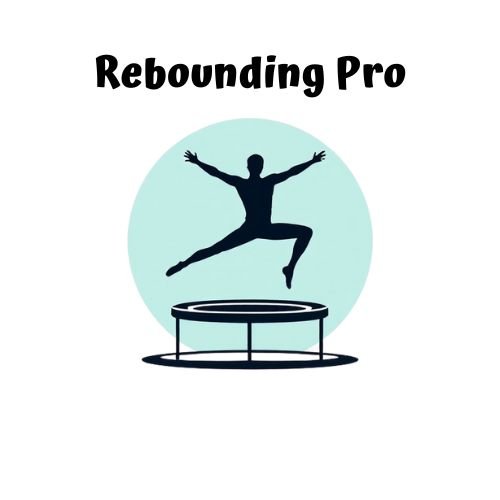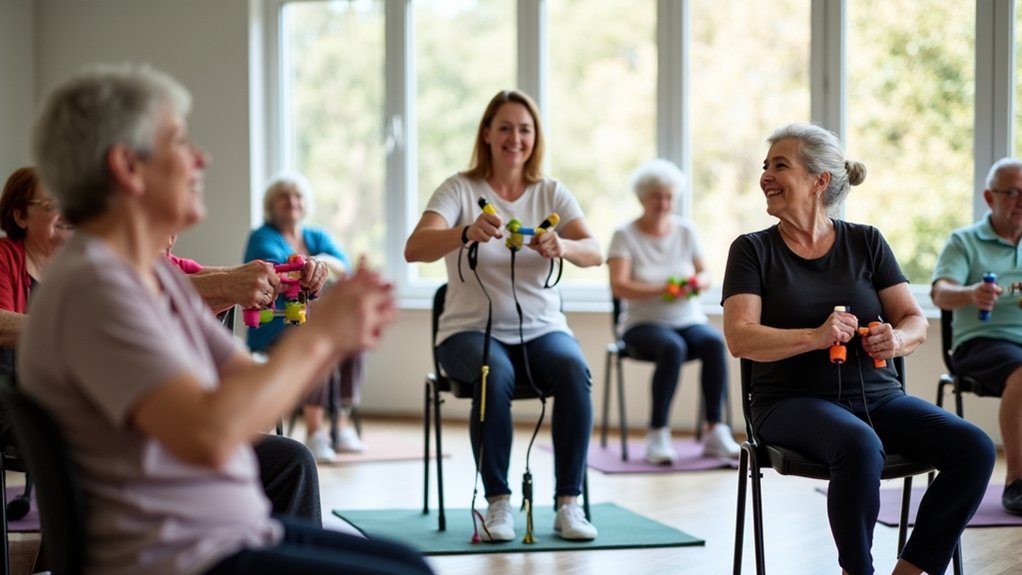Revitalizing your body after chemotherapy requires gentle, strategic approaches. Consider rebounding exercises on a mini-trampoline for 5-10 minutes daily to boost lymphatic circulation and strengthen your cardiovascular system. Start with short sessions and gradually increase as your endurance improves. This low-impact exercise helps rebuild bone density, improves balance, and fights fatigue while supporting mental wellbeing. Your recovery journey benefits from customized intensity based on daily energy levels and consistent progress tracking.
Building Strength Through Gentle Rebounding Exercises

While your body recovers from the rigors of chemotherapy, gentle rebounding exercises on a mini-trampoline offer an effective way to rebuild your strength without overtaxing your system.
This low-impact exercise program promotes cardiovascular fitness and boosts lymphatic circulation, helping reduce the fatigue that often lingers after treatment.
Start with just 10 to 15 minutes of rebounding three times weekly, gradually working up to five sessions as your endurance improves.
Begin with short sessions of 10-15 minutes three times weekly, then build to five as your stamina grows.
You’ll notice enhanced balance and coordination—common challenges during recovery. Rebounding is particularly beneficial if you’re experiencing joint sensitivity or muscle weakness, as it provides effective exercise without strain.
Beyond physical benefits, incorporating rebounding into your routine can improve your mental wellbeing, helping reduce anxiety and depression that sometimes accompany the post-treatment phase.
Lymphatic System Restoration With Low-Impact Bouncing
Your lymphatic system needs stimulation to recover efficiently after chemotherapy treatments, and low-impact bouncing provides this essential circulation boost.
You’ll find that just 5-10 minutes of gentle rebounding daily helps move lymph fluid through your body, preventing the uncomfortable fluid retention that often follows treatment.
These quick bouncing sessions trigger muscle contractions that act as natural pumps, effectively moving excess fluid away from swollen areas and reducing your risk of developing persistent lymphedema.
Circulation Boost Techniques
After enduring chemotherapy, your lymphatic system—a critical component of immune function—often needs targeted support to regain peak performance.
Low-impact bouncing on a mini-trampoline offers an effective circulation boost without straining your recovering body.
- Just 10-15 minutes of gentle rebounding daily enhances lymphatic flow
- This low-impact activity helps flush toxins accumulated during treatment
- Bouncing minimizes joint strain while maximizing fluid movement
- Regular practice reduces swelling and combats treatment-related fatigue
- You’ll experience improved cardiovascular health alongside enhanced recovery
This simple technique works because the lymphatic system lacks its own pump, relying instead on body movement.
Fluid Retention Prevention
Many chemotherapy patients struggle with lymphedema and uncomfortable swelling in their extremities, making fluid retention prevention a critical recovery focus.
Your lymphatic system needs gentle stimulation to effectively remove toxins and excess fluids after treatment.
Low-impact bouncing on a mini-trampoline for just 10-15 minutes daily can greatly improve lymphatic circulation. These gentle bouncing activities create a pumping action that helps move fluid through your body’s lymphatic vessels, reducing swelling and discomfort.
Besides preventing fluid retention, this simple exercise strengthens your muscles and supports cardiovascular health—both essential during recovery.
Many survivors report decreased fatigue and improved energy levels after incorporating rebounding into their routine.
Always check with your healthcare provider before starting any new physical activity post-chemotherapy to verify it’s appropriate for your specific situation.
Cardiovascular Recovery Using Mini-Trampoline Techniques

Mini-trampoline workouts can rebuild your heart strength after chemotherapy with just 15-30 minutes of gentle bouncing three to five times weekly.
You’ll boost circulation and improve cardiovascular fitness while enjoying the low-impact nature that protects your recovering joints.
The rhythmic motion not only strengthens your heart but also releases mood-enhancing endorphins that help combat treatment-related fatigue.
Gentle Bouncing Benefits
While your body recovers from the rigors of chemotherapy, gentle bouncing on a mini-trampoline offers surprising cardiovascular benefits that can accelerate your healing journey.
This low-impact activity enhances your physical recovery while being gentle on weakened joints and muscles.
- Just 10-15 minutes of bouncing several times weekly improves circulation and oxygenation
- The rhythmic motion stimulates lymphatic flow, aiding detoxification processes
- You’ll experience reduced swelling if you’re dealing with treatment-related lymphedema
- Your balance and coordination will improve, essential elements for overall rehabilitation
- The natural mood-boosting effects help combat the fatigue that often lingers after treatment
Heart-Strengthening Rebound Exercises
After experiencing the general benefits of gentle bouncing, it’s time to focus on specific heart-strengthening techniques on your mini-trampoline. Dedicating just 15-20 minutes to rebounding exercises three times weekly can considerably improve your cardiovascular fitness, which is essential for overall recovery after chemotherapy.
Start with basic bouncing, then gradually incorporate more dynamic movements like light jogging in place or gentle knee lifts. These activities stimulate your heart without the harsh impact of traditional cardio exercises, making them ideal for rebuilding endurance safely.
The rhythmic nature of rebounding also enhances your lymphatic flow, helping eliminate toxins and reduce post-treatment fatigue.
This combination of heart health benefits and detoxification makes mini-trampoline workouts an excellent physical activity for cancer survivors seeking to reclaim their strength and energy.
Managing Fatigue With Progressive Rebounding Protocols
For many cancer survivors grappling with post-chemotherapy fatigue, progressive rebounding protocols offer a gentle yet effective path to recovery. By dedicating just 15-30 minutes a few times weekly to this low-impact exercise, you’ll boost your energy levels while strengthening your body’s natural recovery systems.
Gentle rebounding provides cancer survivors a powerful way to rebuild energy while supporting natural healing processes.
- Start slowly with short 5-minute sessions, gradually increasing duration as your stamina improves.
- Focus on gentle bouncing movements that enhance lymphatic circulation, accelerating your detoxification process.
- Customize your rebounding intensity to match your daily energy levels—some days require gentler approaches.
- Combine regular exercise on your mini-trampoline with proper hydration and nutrition for best results.
- Track your progress weekly to celebrate improvements in balance, strength, and reduced fatigue.
Bone Density Rebuilding Strategies on the Rebounder

Chemotherapy’s impact on bone health presents a significant challenge for many cancer survivors.
Fortunately, your mini-trampoline offers an effective solution for rebuilding bone density. The gentle bouncing creates beneficial up-and-down forces that stimulate bone formation without stressing your joints.
Aim for 20-30 minute rebounding sessions 3-5 times weekly to strengthen muscles that support your skeletal system. This consistent exercise improves coordination while enhancing circulation, helping deliver essential nutrients to your recovering bones.
For maximum benefit, try adding resistance bands to your rebounding routine. These simple tools provide additional muscle resistance that further protects against osteoporosis.
Remember to consult your healthcare provider before beginning any new exercise regimen. They’ll help customize a rebounding program that addresses your specific recovery needs and guarantees your safety throughout the bone rebuilding process.
Balance and Coordination Rehabilitation After Treatment
Many cancer survivors experience disrupted balance and coordination as lingering side effects of their treatment. This occurs due to muscle weakness, fatigue, and altered proprioception following chemotherapy.
To reclaim your stability:
- Incorporate balance training exercises like tai chi or yoga, which have shown to reduce falls among cancer survivors.
- Seek specialized physical therapy programs that strengthen core muscles through dynamic movement patterns.
- Practice daily balance activities—try standing on one leg while brushing teeth or walking heel-to-toe.
- Engage in targeted exercises specifically designed for cancer survivors to address treatment-related coordination issues.
- Schedule regular follow-up assessments to track your progress and adjust rehabilitation strategies accordingly.
Frequently Asked Questions
How to Restore Your Body After Chemotherapy?
You’ll restore your body after chemotherapy by gradually adding light exercise, eating nutrient-rich foods, staying hydrated, prioritizing quality sleep, and consulting healthcare providers about supplements that may help manage lingering side effects.
What Makes You Feel Better After Chemo?
You’ll feel better after chemo with gentle exercise, nutrient-rich foods, adequate sleep, stress-reduction techniques, and proper hydration. Don’t underestimate the power of emotional support from loved ones or professional counselors too.
How Long Does Chemo Keep Working in Your Body?
Chemotherapy drugs remain active in your body for varying durations—some for hours or days, others for weeks. You’ll notice acute effects immediately, but certain drugs can impact your body for months or years after treatment.
Why Can’t You Share a Toilet After Chemo?
You shouldn’t share a toilet after chemo because your bodily fluids may contain harmful chemicals that could expose others to risk. Your immune system is also weakened, making you more vulnerable to infections from others.
In Summary
You’ve now discovered how rebounding exercises can transform your recovery journey after chemotherapy. By gradually incorporating these gentle bouncing sessions, you’re supporting your lymphatic system, rebuilding strength, and improving balance—all at your own pace. Remember, it’s not about intensity but consistency. As you continue with your mini-trampoline routine, you’ll reclaim your energy and resilience day by day. Your body will thank you.





Leave a Reply